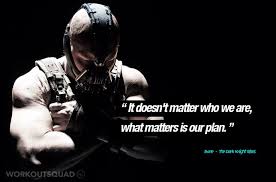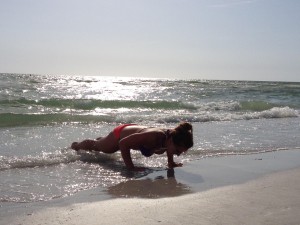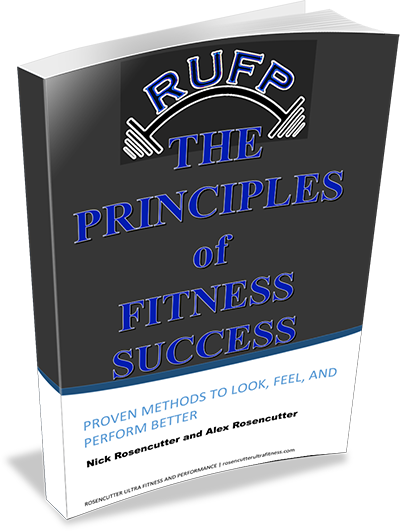
Today we have a great article by coach Dan Zwirlein about the importance of habit formation and behavior. You don’t want to miss this one. If you are looking to start creating some sustainable habits this new year, be sure to check out rufpchallenge.com and join our 21 day program to get started on the right path!
…………………………………………………………………………………..
When trying to learn how to be successful in getting stronger, healthier, losing weight, etc. people always want the tactics. They want to know specifics, the details, the minutia. They want you to tell them exactly what to do. They want a cookbook, a supplement to buy, a new exercise routine to try. Should I eat x or y? Should I buy this brand or this brand? Should I train in the morning or the evening? And on and on. I guess this is probably due to the fact that the things that get the most exposure are magazines like Muscle and Fitness and online forums like bodybuilding.com, etc. These mediums are always posting new workouts and random pieces of information that only serve to confuse the masses. For most, giving out a lot of specifics is not practical nor necessary, and especially not all at once. Giving someone the exact details and minute to minute actions will end up leading a person to failure at some point because it is not sustainable, especially if the actions are the result of a list of details and not formed habits. Most people don’t need a complex, detail oriented plan that’s hard to execute to be successful anyway.
So what matters?
What matters is not a single training or eating ideology; many roads can lead to Rome. What matters is having a simple plan for in and outside of the gym that can be executed correctly and consistently, and with an unwavering mindset.
Having a plan and executing it consistently
It’s easy to use the quote “if you don’t have a plan, you plan to fail” but having a general plan for reaching your fitness or performance goals is imperative. Even if your plan is not optimal (i.e. crossfit), it’s still better than not having one at all. Why is this true? Because the plan provides structure and guidance in the face of scrutiny from peers, bad days at the gym, social functions ( see excessive alcohol consumption), and anything else life throws your way. So when life happens, and it will unless you live in a vacuum, you receive guidance from the plan. For example, when you go out to eat with friends you can adjust accordingly. This means that you can indulge a little, a lot, or not at all. The fact that you did or didn’t doesn’t really matter. What matters is how you adjust or stick to your plan leading up to and after. If you indulged a lot maybe you up your training volume; if just a little maybe you just need to adjust your diet the next day; and if not at all then you probably stuck to your plan. Discipline with the plan leads to freedom and versatility because you always have the plan to go back to. It helps to calm the guilt associated with going off your “diet.”
A plan can also calm some of the effects of decision fatigue. Decision fatigue is a result of the total amount of brain power a person has to use over the course of the day: when you have to decide what clothes to wear, what route to take to work, what to eat for breakfast, what brand of tooth paste you want to use. Those decisions take up valuable brain power; thus, when you get home from work and that bag of (insert treat here) looks really good and accessible, you are a lot more likely to just grab it since you don’t have to put in any work to make them and use more brain power that you might not have. The more brain or thinking power you used over the course of the day, the more likely it is that you will give in to the temptation of eating outside your plan. However, if you have a plan in place, it can do a few things: it can prevent you from buying tempting foods in the first place, it can remind you what is and isn’t on your plan, and finally, if you do give in, it can give you a way to adjust for stepping off of your plan. Another example of this in action is when you don’t feel like going to gym. Now, there are definitely times when listening to yourself and your body is a good thing and you should take a break, like when you are hurt or are sick. I am not talking about those times. I am talking about when motivation is low but otherwise your body feels good or you just have some mild soreness. Making a commitment to go to the gym will be the first thing to go if your decision fatigue from the day is high and your motivation to workout is low. However, if you have a plan in place and it calls for you to go workout that day you don’t have to make the decision. This is one often overlooked aspect of why having scheduled coaching sessions can be so important for many people. It keeps you accountable.
The anatomy of a plan
Having a good plan makes sure everything is accounted for and fits together. Does your diet and training address your goals? Do they complement each other? Are you able to execute your current training, diet, and lifestyle goals? These are the questions a good plan can answer. It should consist of guidelines for inside and outside of the gym. It should address your goals, your current lifestyle or where you are now and where you want to go. Once again, it needs to be easy to understand, easy to execute, and finally, it needs to be flexible.
Let’s take a look at the two areas where you need at least some resemblance of a plan.
Inside the gym
This is the easiest part to execute because it can be controlled the most. What matters is attacking the moment. Being in the present. When you are in the gym, whatever you are working on needs to be your focus even if you are stressed, unmotivated, and tired. Going in and just half assing a workout is going to get you half assed results. So when you are in the gym you need to be all in. In regard to specifics, hard weight training with a barbell, dumbbells, and bodyweight that addresses your goals should be a focal point. The movements should address squatting, pushing, pulling, and hinging in different planes of motion and with complex multi joint exercises as well as single joint exercises. Combining this with aerobic/ cardiac output training is a good starting point for just about everyone, and for most, a good ending point. Do these things 3-4 times a week and you will be surprised at how far it can take you.
Outside the gym
Life outside the gym is where most people fail to get things right. All the distractions of work, family obligations, social events, etc. can make things challenging, but if you have your plan in place and you are steadfast in this plan these events will become a lot less stressful. As mentioned earlier, you can plan around social obligations so you don’t have to be that guy or gal eating out of Tupperware at the party. You can enjoy these opportunities without the guilt because you are disciplined 90% of time. Even 80% of time will be enough for most. Now, this does not work if every weekend or weeknight some social obligation comes up and you just say, “screw it, I was on my plan for one day so now I get rewarded,” but I think this is common sense. Outside of the gym most people just need to hit the low hanging fruit: get 8 hours of sleep, drink water throughout the day ( besides what is in your protein shake), eat “paleo-ish” and eat carbohydrates up to your activity level. This means consuming whole foods, protein from quality sources, and some carbohydrates to fuel training. That’s it; no secrets, no gimmicks, no fads. These are things that most people are already aware of but over-think or don’t seem to execute. A lot of this has to do with the fact that hardly anyone understands what portion sizes actually are, which is usually the underlying mechanism to why they are gaining or losing weight. So once this is understood, the biggest need outside of the gym is having the discipline needed to make it work; it has nothing to do with not having enough information. Prepping food, keeping portions in check, or in the case of gaining weight, eating another meal when you don’t want to is the struggle. Get 8 hours of sleep, drink water, eat real food. Checkmate.
Habit formation/change
Forming the habits to execute a plan is imperative. It goes back to the point made earlier about a plan not being optimal but still being effective. You could have the most perfect training program and diet on paper but if you don’t execute it, who cares? On the flip side, if you can execute a less than perfect plan you are going to see results. Could your results be improved? Absolutely, but the flawed plan you execute is always better than the perfect plan you don’t. So what does this have to do with habit formation and change? Once again, your plan needs to account for your current habits and training level. You need to establish very simple and easy to execute action steps for your current self, not the action steps of someone who has been training and eating properly for 5 years, which is what most try to do. The more wholesale changes you try to make all at once, the more likely you will fail. This is why you see people on and off “the regimen” all of the time. There is always the person that says, “I am going to go to the gym three times this week” after months of not going at all, but if you were to suggest that they start with one day a week or just start walking they look at you like you are crazy. Be patient, be confident in your execution of the habits you are working on, and make slow but steady progress. Another good example of this in action would be to first be aware of your portion sizes and the macro- nutrient composition of your meals; and then the next step would transition into actually tracking your daily intakes.
Mental buy in
Once you have a plan in place, the mental buy-in must also be in place. Your mental buy-in will allow you to stick with a plan when maybe it doesn’t seem to be working, or in some of the scenarios above, like going out to eat with friends. If you are mentally invested in your plan, and more importantly yourself, you will be a lot more likely to invest time into making yourself better. Part of being mentally invested is having the long term in mind. Doing the day to day tasks in accordance to your goals knowing that at some point they will pay off. This is a hard concept for most to grasp but it is really the habit of the daily practice that leads to your success. Not today, or tomorrow, or next week, or next month but sometime in the future. But your goal will never be accomplished unless you stick to your plan in the present. If you don’t have a long term mental mindset, it’s going to be hard to convince yourself to stay focused; it’s going to be hard to convince yourself that the work you are putting in now is going to come to fruition in the future.
Accentuate the positive, eliminate the negative
Another part of the mental side is accentuating the positive and eliminating the negative. This is kind of a cliché thing to say but it still holds true in this context. If you have a positive mental outlook on what you are doing you will be a lot more likely to stick with it, especially in stressful times. Accentuating the positive also means celebrating small wins like setting PR’s in the gym or dropping 10 lbs. It means looking at what you are doing right and what is working with your plan. It also means surrounding yourself with other positive people who support what you are trying to accomplish. The other side of this coin is eliminating the negative. The starting point is finding your bad habits: the ones getting in your way the most and slowly eliminating them. It also means down the road finding things in your plan that aren’t working and possibly making a change. It means eliminating negative people in your life who don’t support what you are trying to accomplish or who feed into your negative habits. The more you can feel positive about, and the more negativity you can eliminate, the better you will be able to link your physical and mental health.
What really matters
All of the things that I have talked about in this article revolve around becoming behavior based and not focusing so much on outcomes; meaning the way that you become successful with fitness, strength, weight loss etc. is not by focusing on the future outcome or so much on the exact minutia of the details, but by focusing on the day to day behaviors. Are you doing the day to day things necessary to be successful? Are you putting time in to prepare your food? Are you committing time to getting good sleep every night? Are you training hard when you do go to gym? Are you sticking to your plan? In my experience, if the proper behaviors are developed, the details work themselves out.
In summary,
*Have a plan or get someone who knows what they are doing to help you develop the plan.
*Execute the plan most of the time, adjusting when you need to.
*Have the proper mindset: accentuate the positive and eliminate the negative.
What really matters is that you have a plan and that you can execute it. Start with this and the rest will take care of itself.









